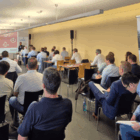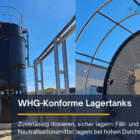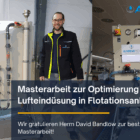Water reuse, also known as water recycling, is a central component of sustainable water management and indispensable for industrial water and wastewater treatment. In times of increasing water scarcity and stricter environmental regulations, the reuse of treated wastewater is becoming increasingly important. It enables the conservation of natural water resources, reduces operating costs and minimizes the environmental impact by reducing wastewater volumes.
Table of contents
Definition and importance of water reuse
Water reuse refers to the treatment of wastewater or process water so that it can be used again for a defined purpose. The quality of the reused water is adapted to the requirements of the respective application, for example cooling water, process water or irrigation water.
Advantages of water reuse:
Conservation of resources:
- Reduction in the extraction of fresh water from natural sources such as rivers or groundwater.
Cost savings:
- Lower water extraction and disposal costs thanks to closed circuits.
Sustainability:
- Reduction of wastewater discharge into public sewer networks or bodies of water, thereby reducing environmental pollution.
Compliance with legal requirements:
- Support in meeting strict environmental regulations and water withdrawal restrictions.
Technological principles of water reuse
Water reuse requires a precise selection and combination of treatment processes in order to adapt the quality of the recycled water to the specific requirements of the respective application. These processes can be divided into physical, chemical and biological categories, which are often combined to ensure optimum treatment.
1. physical procedures
Filtration
Filtration is a basic physical method that removes suspended solids, particles and other impurities from water. It is often used as a pre-treatment to reduce the load on subsequent processes and increase their efficiency.
- Multimedia or multilayer filter:
- These filters consist of several layers of different materials such as quartz sand, anthracite or activated carbon. Each layer has specific properties to remove particles of different sizes and densities.
- Area of application: Removal of suspended solids, particles and coarse impurities, for example during pre-treatment before membrane processes.
- Advantages: Robust, low-maintenance and suitable for large volume flows.
Ion exchanger systems
Ion exchange systems are powerful physical-chemical systems that remove dissolved ions through specific exchange reactions. They offer precise control over the water composition and are often used in combination with other physical processes.
Functionality:
- Ion exchange resins bind specific cations (e.g. calcium, magnesium) or anions (e.g. chloride, sulphate) and replace them with hydrogen or hydroxide ions.
- Once the resins are saturated, the system is regenerated by adding chemicals such as caustic soda (NaOH) or hydrochloric acid (HCl).
Field of application:
- Softening: Removes hardness formers such as calcium and magnesium to prevent deposits.
- Desalination: Reduces the conductivity to provide fully desalinated water for applications such as boiler feed water or process water.
Advantages:
- High efficiency and selectivity for specific ions.
- Regenerable, which reduces operating costs.
- Ideal for the post-treatment of water in demanding processes.

Photo: Our ALMA FIL multi-layer filters with downstream ALMA ION ion exchanger
Membrane process
Membrane processes use semi-permeable membranes to remove dissolved and undissolved substances from the water. They offer high efficiency and flexibility, particularly in the treatment of process water and pure water.
- Removes particles, bacteria, viruses and colloidal impurities through membranes with pore sizes of 0.01 to 0.1 micrometers.
- Area of application: Pre-treatment for reverse osmosis systems and treatment of process water in the food and beverage industry as well as in cooling circuits.
- Advantages: High retention rate with low operating and maintenance costs.
- Uses high pressure to force water through a membrane that retains dissolved salts, organic compounds and micropollutants.
- Area of application: Production of pure water or demineralized water for the electronics, pharmaceutical and energy industries.
- Advantages: Removes up to 99% of dissolved substances and provides excellent water quality.
UV disinfection
UV disinfection uses ultraviolet light to inactivate microorganisms such as bacteria, viruses and parasites.
- How it works: UV light destroys the DNA of microorganisms and thus prevents them from multiplying.
- Field of application: Disinfection of process water or as a final step after biological and chemical processes.
- Advantages: Chemical-free, easy to install and effective against a wide range of germs.
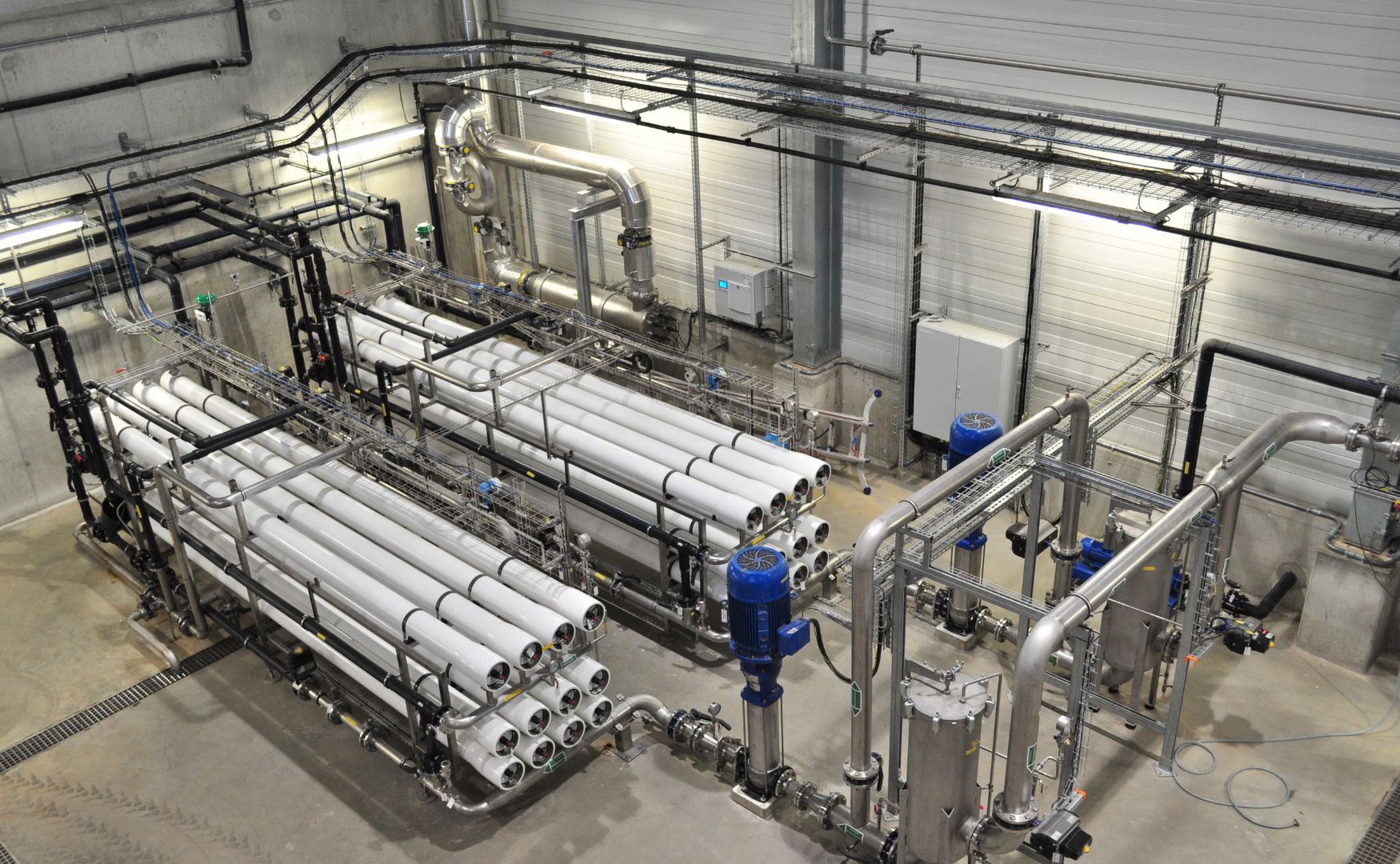
Photo: Our reverse osmosis system for in-house water recycling
2. chemical processes
Precipitation and flocculation
Precipitation and flocculation systems are based on chemical/physical processes that convert dissolved or colloidal impurities into solid particles that can then be removed.
Felling:
- Addition of chemicals such as iron or aluminum salts, which convert dissolved compounds such as phosphates or heavy metals into insoluble solids.
Flocculation:
- Addition of polymers or other flocculants to aggregate the formed particles into larger flocs.
- Area of application: Removal of heavy metals, phosphates and organic substances in the food and metal processing industries.
Oxidation process
Oxidation processes use strong oxidizing agents to break down organic compounds and micropollutants.
Oxidizing agents used:
- Ozone: Strong oxidizing agent that effectively breaks down organic compounds.
- Hydrogen peroxide: Often used in combination with UV light or ozone to generate hydroxyl radicals.
- Advanced Oxidation Processes (AOPs)Combined processes that use hydroxyl radicals to achieve high oxidation performance.
Area of application: Removal of micropollutants such as pharmaceutical residues, pesticides or biofilms.

Photo: Our CP system with neutralization and activated carbon filtration for the pre-treatment of wastewater containing heavy metals prior to reverse osmosis
3. biological processes
Activated sludge process
The activated sludge process is an aerobic process in which microorganisms break down organic substances in wastewater.
How it works:
- Microorganisms oxidize organic substances in an aerated tank to CO₂ and biomass.
- The retention time in the aeration tank is decisive for the efficiency of the process.
Advantages:
- Effective reduction of COD (chemical oxygen demand) and BOD (biochemical oxygen demand).
- Widely used and robust in operation.
Biofiltration
Biofiltration combines biological and physical processes by colonizing microorganisms on a carrier material.
How it works:
- The water flows through filter materials on which bioactive films grow. These microorganisms break down organic pollution and nutrients such as ammonium.
Field of application: Removal of residual contamination in waste water treatment or as pre-treatment for reverse osmosis systems.
Advantages:
- Compact design.
- High extraction performance with low operating costs.
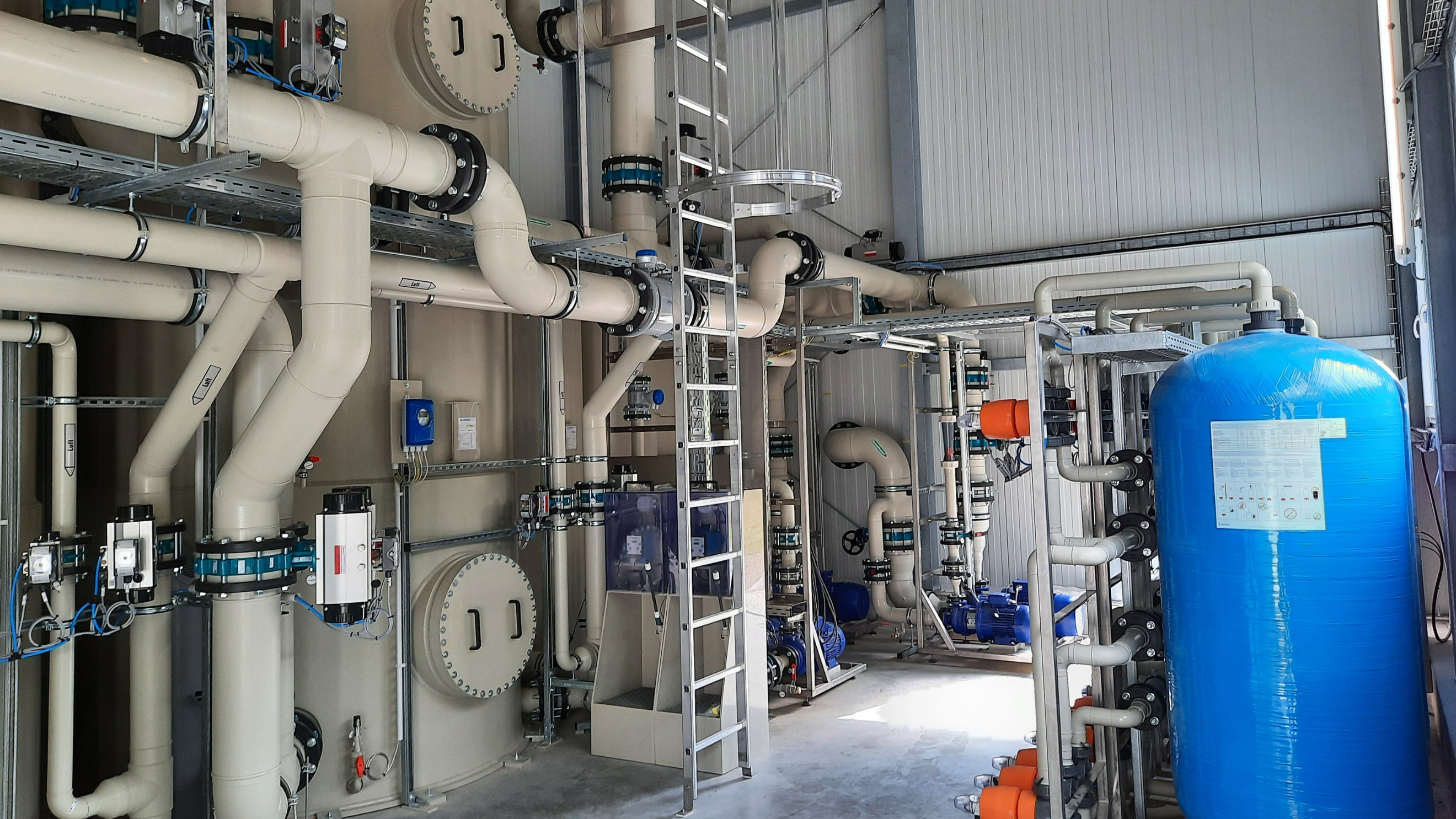
Photo: Our biofiltration for the pre-treatment of organically contaminated wastewater upstream of a reverse osmosis system
Applications of water reuse
Water reuse plays a central role in numerous industries and processes. It helps to conserve resources, reduce costs and comply with legal requirements. The requirements for the quality of the recycled water depend heavily on the respective area of application and determine the choice of treatment process. The most important areas of application are explained in detail here:
1. process water
Process water is used in industrial processes as a direct or indirect component in production processes. The water quality requirements depend on the type of process and the specific products.
Requirements:
- Low salt concentration:
- High salt levels can disrupt chemical reactions or cause undesirable deposits on machines and systems.
- High chemical stability:
- Fluctuations in the pH value or conductivity of the water can impair production processes.
Typical procedures:
- Reverse osmosis (RO):
- Effective removal of dissolved salts and other ions to ensure consistently high water quality.
- Ion exchange:
- Used in addition to reverse osmosis to remove specific ions that can interfere with highly sensitive processes.
Applications:
- Chemical industry: Provision of water for syntheses.
- Pharmaceutical production: manufacture of medicinal products and active ingredients.
2. cooling water
Cooling water is an essential component in many industries, especially in power generation and chemical production. It is used to control temperatures and protect systems from overheating.
Requirements:
- Low solids content:
- Solids can lead to deposits in heat exchangers and cooling systems.
- Low conductivity (below 150 µS/cm):
- A low conductance reduces the risk of corrosion and deposits, which impair the efficiency of cooling systems.
Typical procedures:
- Multilayer filter:
- Effectively remove suspended solids and particles that could pollute the systems.
- Ion exchange:
- For softening and reducing conductivity by removing calcium, magnesium and other conductive ions.
Applications:
- Power plants: Cooling of turbines and generators.
- Chemical plants: Cooling of reactors and processes.
3. boiler water
Boiler water is used to generate steam in industrial processes and power plants. The water quality requirements here are particularly high, as impurities can lead to corrosion and deposits in boilers and pipelines.
Requirements:
- Extremely low hardness:
- Prevents the formation of scale and deposits.
- Very low salt concentrations:
- Minimizes the risk of corrosion and conductivity problems.
Typical procedures:
- Reverse osmosis:
- Removes dissolved salts and organic compounds as a precursor.
- Ion exchange:
- For the production of demineralized water (demineralized water) by exchanging cations and anions.
Applications:
- Power generation: Steam turbines and boilers.
- Chemical and petrochemical industry: steam injection for production processes.
4. water for the food and beverage industry
In the food and beverage industry, the requirements for water quality are particularly high, as the water comes into direct or indirect contact with the products.
Requirements:
- Highest purity:
- Contaminants such as heavy metals, germs and organic substances are not permitted as they could impair the quality of the end products.
- Free from germs and organic residues:
- Hygiene and food safety are paramount.
Typical procedures:
- Ultrafiltration (UF):
- Removal of bacteria, viruses and suspended particles to ensure microbiological purity.
- Reverse osmosis (RO):
- For desalination and removal of organic and inorganic pollutants.
- UV disinfection:
- Chemical-free disinfection to inactivate microorganisms.
Applications:
- Beverage production: production of soft drinks, beer and mineral water.
- Food production: cleaning of equipment and ingredients, production of products such as soups or sauces.

Photo: Our reverse osmosis system for in-house water recycling
Planning and optimization of water recycling plants
Analysis of the water quality
- Detailed investigation of the chemical, physical and biological properties of the wastewater.
Dimensioning of the system
- Design of the treatment capacity based on the volume flow and the inlet load.
Process integration
- Integration of the water recycling plant into existing production processes to create closed water cycles.
Monitoring and control
- Automated sensor technology and process control to ensure compliance with water quality standards.
Conclusion
Water reuse is a decisive step towards a more sustainable and resource-efficient water management. Through the targeted use of modern technologies such as membrane processes, biofiltration and CP systems, companies can use their water resources efficiently, reduce operating costs and comply with environmental regulations.
In industry in particular, the reuse of water offers a wide range of opportunities to create closed cycles, reduce wastewater volumes and at the same time ensure a reliable supply of process water. Careful planning and regular monitoring of recycling processes are essential to ensure high water quality and long-term operational efficiency.
For further information on our products, please feel free to contact us at any time!



